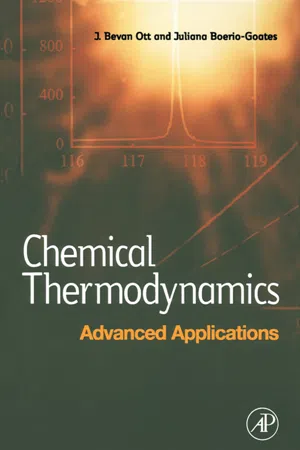
Chemical Thermodynamics: Advanced Applications
Advanced Applications
- 260 pages
- English
- ePUB (mobile friendly)
- Available on iOS & Android
Chemical Thermodynamics: Advanced Applications
Advanced Applications
About This Book
This book is an excellent companion to Chemical Thermodynamics: Principles and Applications. Together they make a complete reference set for the practicing scientist. This volume extends the range of topics and applications to ones that are not usually covered in a beginning thermodynamics text. In a sense, the book covers a "middle ground" between the basic principles developed in a beginning thermodynamics textbook, and the very specialized applications that are a part of an ongoing research project. As such, it could prove invaluable to the practicing scientist who needs to apply thermodynamic relationships to aid in the understanding of the chemical process under consideration.
The writing style in this volume remains informal, but more technical than in Principles and Applications. It starts with Chapter 11, which
summarizes the thermodynamic relationships developed in this earlier volume. For those who want or need more detail, references are given to
the sections in Principles and Applications where one could go to learn more about the development, limitations, and conditions where these equations apply. This is the only place where Advanced Applications ties back to the previous volume. Chapter 11 can serve as a review of the fundamental thermodynamic equations that are necessary for the more sophisticated applications described in the remainder of this book. This may be all that is necessary for the practicing scientist who has been away from the field for some time and needs some review. The remainder of this book applies thermodynamics to the description of a variety of problems. The topics covered are those that are probably of the most fundamental and broadest interest. Throughout the book, examples of "real" systems are used as much as possible. This is in contrast to many books where "generic" examples are used almost exclusively. A complete set of references to all sources of data and to supplementary reading sources is included. Problems are given at the end of each chapter. This makes the book ideally suited for use as a textbook in an advanced topics course in chemical thermodynamics.
- An excellent review of thermodynamic principles and mathematical relationships along with references to the relevant sections in Principles and Applications where these equations are developed
- Applications of thermodynamics in a wide variety of chemical processes, including phase equilibria, chemical equilibrium, properties of mixtures, and surface chemistry
- Case-study approach to demonstrate the application of thermodynamics to biochemical, geochemical, and industrial processes
- Applications at the "cutting edge" of thermodynamics
- Examples and problems to assist in learning
- Includes a complete set of references to all literature sources
Frequently asked questions
Information
Summary of Thermodynamic Relationships
Table of contents
- Cover image
- Title page
- Table of Contents
- Copyright
- Preface to the Two-Volume Series Chemical Thermodynamics: Principles and Applications and Chemical Thermodynamics: Advanced Applications
- Preface to the Second Volume Chemical Thermodynamics: Advanced Applications
- Chapter 11: Summary of Thermodynamic Relationships
- Chapter 12: Thermodynamics of Other Variables
- Chapter 13: Applications of Thermodynamics to Phase Equilibria Studies of Pure Substances
- Chapter 14: Applications of Thermodynamics to Phase Equilibria Studies of Mixtures
- Chapter 15: Applications of Thermodynamics to Chemical Processes
- Chapter 16: Applications of Thermodynamics to Biological Processes
- Chapter 17: Applications of Thermodynamics to Nonelectrolyte Solutions
- Chapter 18: Applications of Thermodynamics to Solutions Containing Electrolyte Solutes
- Thermodynamic Properties of Selected Chemical Substances
- Calculations from Statistical Thermodynamics
- Coefficients for Pitzer’s Equations
- Index